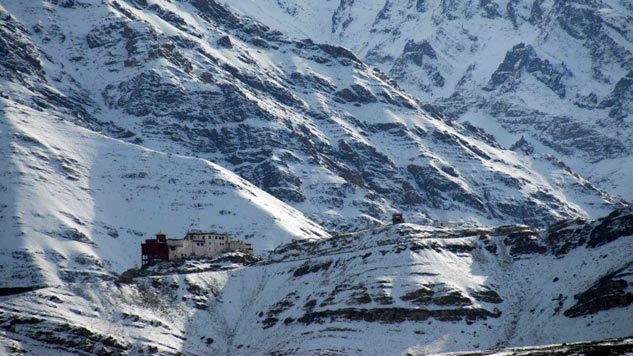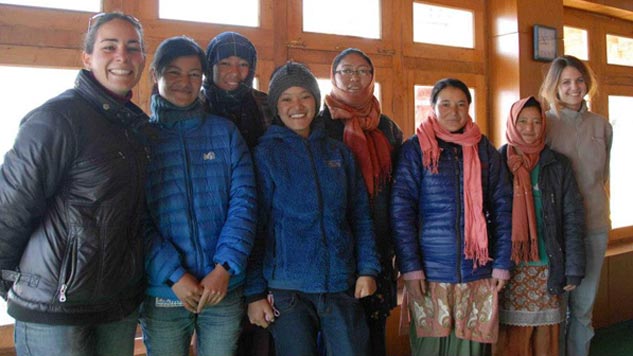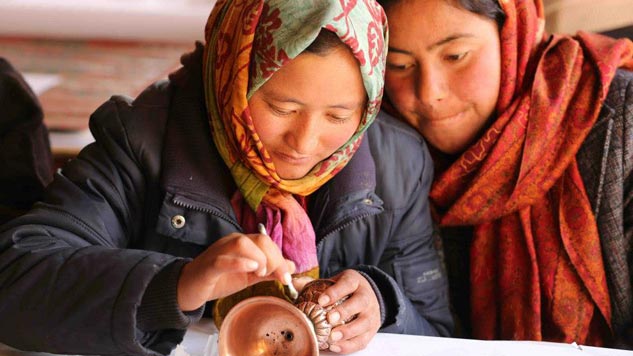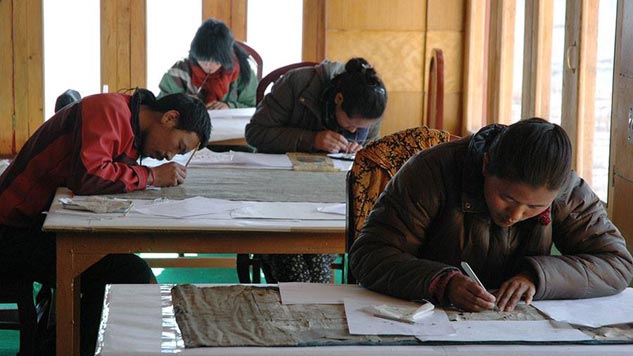Perched at an altitude of 3800 m in the Indus Valley in Ladakh, a Buddhist monastery recently revealed its treasures. Since then Matho has been working on bringing the invaluable heritage back to life before the eyes of the Ladakhis. To learn more about this exceptional initiative, we asked some questions to Nelly Rieuf who heads the Museum Project.
Hi Nelly, can you give us a brief introduction of yourself?
I am French, I’m turning 32 years old today. I did my engineering in physical chemistry, followed by restoration of works of art and art history. I also have training in Himalayan art restoration. These three complementary profiles now help me to manage different aspects of the project: construction, research and restoration of art objects. My husband and I live in Ladakh, on site. For 3 months of the year, I teach chemical microanalysis on works of art in France. My Himalayan art restoration training put me in touch with an international network that needed fund collection, project communication etc.
How did the idea for Project Matho originate and when was it launched?
Originally the idea came from the 34 monks of the monastery of Matho. They envisaged a museum for their valuable collection of artefacts of great historical and religious value. They wanted to share this treasure, as many of these are objects of worship. But their great financial value did not allow for them to be displayed in public without adequate security. To protect the artwork, the monks therefore wanted to create a small museum. Finally, the Delhi National Museum Institute undertook to create a model museum that could be replicated in India. So I ended up in charge of the project Matho in early 2012.
How many people are working on the project Matho?
There are 55 people on the project, divided uniformly into three areas:
– The artisans of the construction: I take care of a team of foremen, masons, labourers, and carpenters
– Restorers of the village: specialized and trained for 3 years in restoration techniques. In addition to restoring the works, they now know how to determine the source and date of an artwork. This is one of our team’s unique expertises!
– Volunteers: a team of international experts from various fields train local restaurateurs and those who occupy the museum. They take care of the communication of the project, preparation of the exhibition, looking for funding etc. We have an outstanding team that is passionate about the project. While very few organizations can afford to employ such experts, at Matho they work voluntarily. Volunteers usually come for a 3-month period, then some of them return for another year or even more, because they are happy to be associated with Matho.
– And of course the monks that validate each step of the project that I present to them.
What is the progress of the project so far?
As of March 2015, the building is almost finished. The inauguration of the museum building is scheduled for 5th July 2015. HH Sakya Trizin, the great spiritual leader of the Sakya Buddhists of the Himalayas, will be there to give his blessings. The ceremony will be open to the public. Several local dignitaries, ministers, donors and all stakeholders in the Matho project will also be present. The inauguration of the museum exhibition will take place in the summer of 2016.
Can travelers attend other events this summer at Matho?
Of course, the usual events of the Matho monastery will take place. The workshop is always open for visitors. The restoration process is very fascinating to watch! When you see the state in which the artworks are found and then the state in which we bring them back, you’ll be astonished. Come and meet our team to see for yourself!
For 3 years, you have seen the project grow. How has the interest of Ladakhis in their heritage changed?
I feel that greater cultural sensitivity has developed in Matho. The monks did not imagine even for a second that a relic could be restored. They now know that relics can come back to life even when they are damaged. They are fascinated that we can save the new collections and perform religious rituals in these works.
You should know that Ladakh was only opened to the world some 30 years ago. This was followed by an identity crisis in the face of globalization and modernity. I feel that through the project of Matho, villagers are strengthening their identity, thanks to the recovery of their culture.
The Ladakhis are also coming to understand that the works they hold have a history. The landlocked Ladakh has historically been visited by the great masters from Tibet and Kashmir. Yes, Ladakhis have a graphic and artistic vocabulary with a unique aesthetic of its own. Tibet remains the great model, however, and they are very proud to embrace their Tibetan heritage.
What are the other benefits of the Matho project for the local population?
The team of 16 women restorers from the village are very proud of their work. They have discovered their independence through this work and it has drastically improved their lives. These women are especially passionate about the project! They are motivated, punctual, serious and talented. This project really helps to improve their social status. They don’t have to rely solely on their family, which makes a big difference in a crisis situation.
The monks have also changed. This small community of men has become accustomed to the presence of foreign women. It has increased their openness. Now even the nuns who dissented our presence earlier are happy that the monks are more attentive towards women. And another thing is that the Matho project gave the monks the option to travel. They can obtain additional education beside their religious scholarship. Some have even gone on to tour the world and return to Matho with a broader vision. I was not at all expecting such a change in the monks.
What will be the result of your project? Perhaps a Matho elsewhere?
We are preparing the exhibition for the summer of 2016. The project will move very gradually. I want to put together a support framework for about 10 years and will also be present for the opening and closing of each season. Then I might establish a collection mapping the art of Ladakh, using Matho as a project reference. Ladakhi monasteries will start to know me and I might be able to win their confidence. That’s when they might come around to revealing their secret collections to me, which will be such a privilege!
If you also like monks, want to learn more about the world and open up to others, then you must travel to Ladakh. You will get a chance to see the completed project and meet Nelly, this fairy personified whose passion is contagious. For further information and to support the project: http://www.mathomuseumproject.org/
Shanti Travel supports the Matho project and offers customized trips and treks in Ladakh. For more information: http://www.shantitravel.com/en/indian-himalayas/ladakh-trekking/















